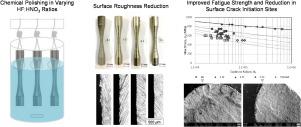Materials Today Communications ( IF 3.8 ) Pub Date : 2020-06-29 , DOI: 10.1016/j.mtcomm.2020.101396 Martin Bezuidenhout , Gerrit Ter Haar , Thorsten Becker , Sabrina Rudolph , Oliver Damm , Natasha Sacks

|
Metal additive manufacturing is increasingly utilised for the production of customised components. Post-process operations are required to address the high surface roughness of as-built components which is detrimental for load-bearing applications. Parts produced by metal additive manufacturing often have complex- surfaces and geometrical features rendering mechanical finishing processes impractical. This study investigates the chemical polishing of laser powder bed fusion (LPBF) produced Ti6Al4V axial fatigue test specimens in HF-HNO3 solutions with different initial HF concentrations (1, 2, and 4 M) and a constant initial HNO3 concentration (3.17 M). Polishing efficacy was evaluated in terms of mass removal, surface roughness reduction, and resulting tension-tension fatigue strength. The 4 M HF solution resulted in both the highest mass removal and surface roughness reduction; however, when evaluated relative to resource consumption, the processing efficiency decreases more drastically than that of the 1 and 2 M HF solutions. Specimens polished in all three solutions had higher fatigue strengths and fewer surface crack initiation sites than the as-built condition. Specimens polished in 2 M solutions exhibited better fatigue performance than specimens polished in 1 M solutions while statistical significance was lacking between the fatigue strengths of specimens polished in 2 M and 4 M solutions.
中文翻译:

HF-HNO 3化学抛光对激光粉末床熔融制备Ti6Al4V的表面粗糙度和疲劳寿命的影响
金属增材制造越来越多地用于生产定制组件。需要进行后处理操作以解决所制造组件的高表面粗糙度,这对于承重应用是有害的。通过金属增材制造生产的零件通常具有复杂的表面和几何特征,从而使机械精加工工艺变得不切实际。这项研究调查了在不同初始HF浓度(1、2和4 M)和恒定初始HNO 3的HF-HNO 3溶液中对激光粉末床熔合(LPBF)生产的Ti6Al4V轴向疲劳测试样品进行的化学抛光。浓度(3.17 M)。根据质量去除,表面粗糙度降低和所得的拉-拉疲劳强度来评估抛光功效。4 M HF溶液可实现最高的质量去除率和表面粗糙度降低。但是,相对于资源消耗进行评估时,处理效率比1和2 M HF解决方案的处理效率急剧下降。在所有三种溶液中抛光的试样比在建状态下具有更高的疲劳强度和更少的表面裂纹萌生部位。在2 M溶液中抛光的试样比在1 M溶液中抛光的试样具有更好的疲劳性能,而在2 M和4 M溶液中抛光的试样的疲劳强度之间缺乏统计学意义。


























 京公网安备 11010802027423号
京公网安备 11010802027423号